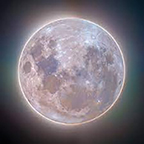
On August 30, the Second Full Supermoon of the month will Shine, and it holds the Distinction of Being a Blue Moon Despite its Lack of a Blue hue.
By Stacy M. Brown, NNPA Newswire Senior National Correspondent@StacyBrownMedia
As August draws to a close, sky gazers are in for a celestial treat as a rare super blue moon graces the heavens. This month has already delighted stargazers with a supermoon at its outset, but the celestial show is still ongoing. On August 30, the second full supermoon of the month will shine, and it holds the distinction of being a blue moon despite its lack of a blue hue. In astronomical terms, a blue moon refers to the occurrence of a second full moon within a single calendar month.
The lunar spectacle started with the first full moon of August, which appeared on August 1 and marked the second installment in a series of four consecutive supermoons. Experts said these natural phenomena stand out by shining approximately 16% brighter than an average full moon while appearing more prominent in the night sky. To put it in perspective, NASA equates the difference in apparent size to that between a quarter and a nickel. Supermoons occur when the moon’s elliptical orbit brings it closest to Earth, precisely when it’s fully illuminated.
When the supermoon graces the night of August 30, it will seem even closer and larger than its lunar counterpart from the beginning of the month. As the grand finale of this year’s consecutive supermoons, the “Harvest Moon” will rise on September 28. Those who miss the upcoming blue moon must exercise patience, as blue moons are a rarity, accounting for just 3% of full moons. In contrast, about a quarter of all full moons are supermoons. The subsequent opportunity to witness a blue moon will present in May 2026. However, astronomy enthusiasts can anticipate an extraordinary occurrence in 2037, with super blue moons set to grace the skies in January and March.
The pivotal moment of this Wednesday’s super blue moon is set to occur at 9:36 p.m. EDT. Stargazers who peer upwards may also catch a glimpse of Saturn near the moon around 8:42 p.m. EDT. As the night unfolds, Saturn will appear to traverse the moon’s vicinity clockwise—an event worth witnessing. Although Saturn is observable by simply looking upwards, using binoculars or a telescope can unveil the planet’s distinctive features with greater clarity.
Having recently reached opposition with the sun on a Saturday night, Saturn will remain in this position until Sunday night. This alignment, coupled with the sun’s illumination, will lend the ringed planet an appearance of increased size and brilliance in the night sky, as detailed by NASA. The opportunity to marvel at Saturn’s splendor will persist until February of the coming year.


Be the first to comment